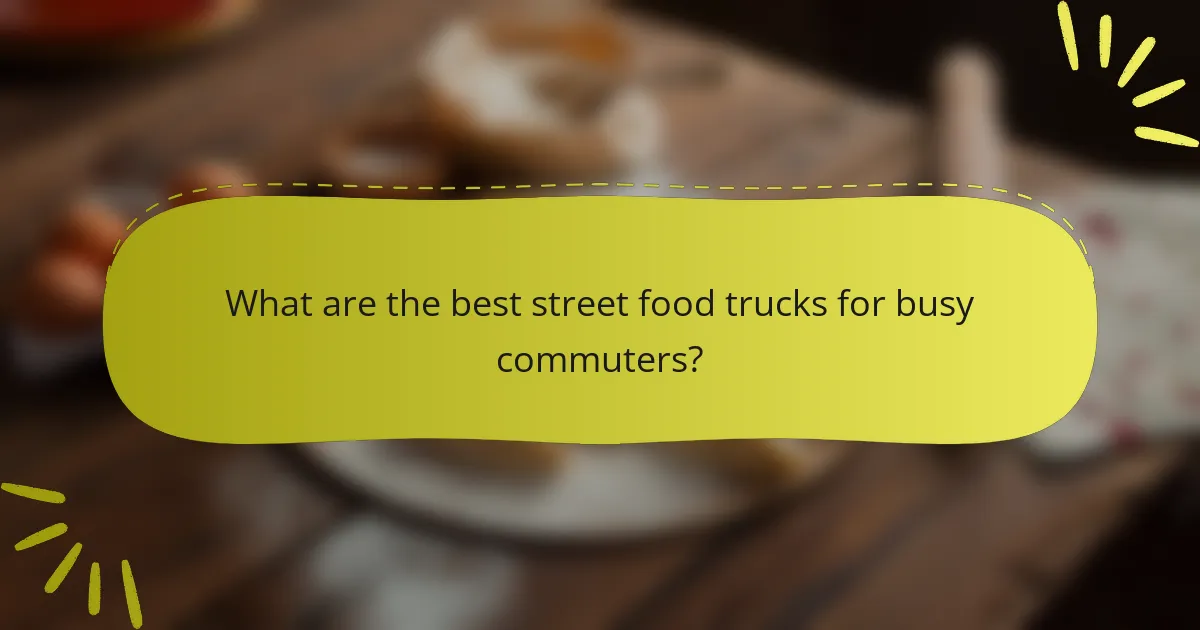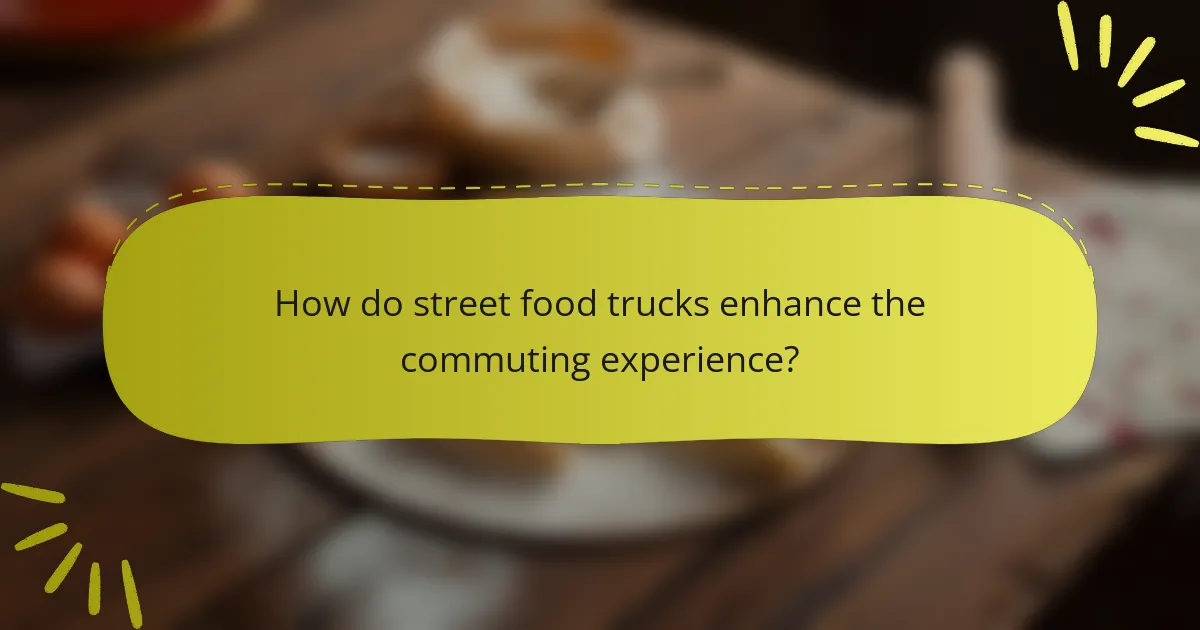The article focuses on the best street food trucks for busy commuters, emphasizing their strategic locations, speed of service, and diverse menu offerings. Notable food trucks highlighted include The Halal Guys, known for quick Mediterranean meals, and Kogi BBQ, which features Korean-Mexican fusion dishes. These trucks are positioned near transit hubs to cater to time-constrained individuals seeking quality meals on the go. The article also provides guidance on selecting the best food trucks based on proximity, menu variety, customer reviews, and service efficiency, enhancing the overall commuting experience.

What are the best street food trucks for busy commuters?
The best street food trucks for busy commuters include those offering quick service and convenient locations. Notable examples are The Halal Guys, known for their fast Mediterranean dishes, and Kogi BBQ, which serves Korean-Mexican fusion. These trucks are often strategically placed near transit hubs. They cater to time-constrained individuals seeking quality meals on the go. Their menus typically feature popular items that can be prepared quickly. For instance, The Halal Guys’ platters are ready in minutes. Kogi BBQ’s tacos are also served promptly, making them ideal for commuters.
How do location and accessibility impact street food truck choices?
Location and accessibility significantly influence street food truck choices. A truck situated in a high-traffic area attracts more customers. Accessibility ensures that potential customers can easily reach the food truck. For example, proximity to public transportation hubs increases foot traffic. Trucks near office buildings cater to busy commuters during lunch hours. Research shows that 70% of street food customers prioritize convenience. Limited parking or difficult access can deter customers from choosing a food truck. Therefore, strategic placement is crucial for maximizing sales and customer engagement.
What are the top locations for street food trucks frequented by commuters?
The top locations for street food trucks frequented by commuters include busy urban centers, transportation hubs, and popular parks. Major cities like New York, Los Angeles, and Chicago have high concentrations of food trucks. Commuters often visit food trucks near subway stations and bus terminals for quick meals. Events and festivals also attract food trucks, providing diverse options. Research indicates that food trucks near office complexes see significant foot traffic during lunch hours. Specific streets known for food trucks include 5th Avenue in New York and Food Truck Row in Los Angeles. These locations cater to the fast-paced needs of commuters seeking convenient dining options.
How do traffic patterns influence the placement of food trucks?
Traffic patterns significantly influence the placement of food trucks. Food trucks tend to locate in high-traffic areas to maximize customer reach. Areas with heavy foot traffic, such as business districts or near public transportation hubs, are prime spots. Traffic flow data shows that peak hours impact sales; thus, trucks align their schedules accordingly. For instance, food trucks often operate during lunch hours when office workers are on break. Research indicates that food trucks positioned near busy intersections see increased patronage. Additionally, understanding local events can lead to strategic placements to capture larger crowds. Overall, traffic patterns dictate optimal locations, ensuring food trucks serve the most potential customers efficiently.
Why is speed of service crucial for busy commuters?
Speed of service is crucial for busy commuters because they have limited time to eat. Quick service allows them to grab meals efficiently during short breaks. According to a study by the National Restaurant Association, 70% of consumers prefer fast service when dining on-the-go. This preference drives street food trucks to optimize their operations. Efficient service reduces wait times, enabling commuters to return to their schedules promptly. High-speed service also enhances customer satisfaction, leading to repeat business. Therefore, the speed of service directly impacts the viability of food options for those with tight schedules.
What factors contribute to quick service at food trucks?
Quick service at food trucks is influenced by several key factors. Efficient menu design allows for faster order processing. Limited options reduce decision-making time for customers. Pre-prepared ingredients enable quicker assembly of dishes. Skilled staff are trained to work swiftly under pressure. Strategic location near high foot traffic areas increases customer flow. Use of technology, like mobile ordering, streamlines the ordering process. These factors collectively enhance the speed of service at food trucks.
How do food trucks manage long lines during peak hours?
Food trucks manage long lines during peak hours by implementing efficient service strategies. They often employ multiple staff members to take orders and prepare food simultaneously. This reduces wait times significantly. Many food trucks also utilize pre-ordering systems through mobile apps. This allows customers to place orders ahead of time. Additionally, they may offer a limited menu during busy periods to expedite service. Streamlined payment processes, such as mobile payments, further speed up transactions. Many food trucks also strategically position themselves in high-traffic areas to attract more customers. Collectively, these methods help food trucks effectively handle large crowds during peak hours.
What menu highlights should commuters look for in food trucks?
Commuters should look for quick, portable meals in food trucks. Popular highlights include tacos, sandwiches, and wraps. These options are easy to eat on the go. Additionally, food trucks often feature daily specials that provide variety. Seasonal ingredients can enhance freshness and flavor. Vegetarian and vegan options are increasingly available, catering to diverse diets. Signature dishes can showcase the truck’s unique style. Lastly, beverages like fresh juices or coffee complement the meal choices.
Which types of cuisine are most popular among busy commuters?
Fast-casual and street food cuisines are most popular among busy commuters. These types of cuisine offer quick service and portability. Popular options include tacos, sandwiches, and sushi rolls. Many commuters prefer meals that are easy to eat on the go. According to a survey by the National Restaurant Association, 60% of consumers seek convenience in their meals. Additionally, food trucks often serve diverse options appealing to various tastes. This variety helps attract a wide commuter demographic.
How do food trucks cater to dietary restrictions and preferences?
Food trucks cater to dietary restrictions and preferences by offering diverse menu options. Many food trucks provide vegetarian, vegan, gluten-free, and allergen-friendly choices. They often label their ingredients clearly to inform customers. Some food trucks customize meals based on customer requests. This flexibility allows them to accommodate various dietary needs. Research shows that 30% of consumers prioritize food options that meet their dietary restrictions. Food trucks that adapt their menus can attract a broader customer base.

How do street food trucks enhance the commuting experience?
Street food trucks enhance the commuting experience by providing convenient, quick meal options for busy individuals. They are strategically located near high-traffic areas, making access easy for commuters. The speed of service is typically fast, allowing customers to grab food in a short time. Many food trucks offer diverse menus that cater to various tastes and dietary preferences. This variety can make meals more enjoyable during commutes. Additionally, food trucks often feature local and fresh ingredients, which can enhance the quality of the food. Their presence contributes to a vibrant street culture, making the commuting environment more lively and engaging.
What role do food trucks play in urban food culture?
Food trucks serve as vital components of urban food culture. They provide diverse culinary options in convenient locations. Food trucks often reflect local tastes and trends. They foster community engagement through social interactions. Many food trucks offer quick service, catering to busy commuters. A study by the National Restaurant Association indicates that food trucks have increased by 7.5% annually since 2014. This growth highlights their popularity and significance in urban settings. Food trucks also support local economies by creating jobs and promoting small businesses.
How do food trucks support local economies?
Food trucks support local economies by creating jobs and generating revenue. They often require minimal startup costs compared to traditional restaurants. This accessibility allows entrepreneurs to enter the food industry more easily. Food trucks also contribute to local tax revenues through sales taxes. They frequently source ingredients from local farmers and suppliers, promoting local agriculture. Additionally, food trucks attract customers to specific areas, boosting foot traffic for nearby businesses. According to a report by the National Food Truck Association, food trucks can generate up to $1 million in annual sales, benefiting the local economy significantly.
What community events often feature food trucks?
Community events that often feature food trucks include festivals, fairs, and markets. Food trucks are popular at music festivals, providing diverse meal options. Local fairs often invite food trucks to enhance the food offerings. Farmers’ markets frequently include food trucks to attract visitors. Street fairs also showcase food trucks, promoting local cuisine. Community celebrations, such as parades, often have food trucks for convenience. Seasonal events, like summer block parties, typically feature food trucks to cater to attendees. These events leverage food trucks for their variety and accessibility.
What are the trends shaping the street food truck industry?
The trends shaping the street food truck industry include a focus on sustainability, diverse cuisine offerings, and technology integration. Sustainability is becoming crucial as consumers prefer eco-friendly practices. Many food trucks are using biodegradable packaging and sourcing local ingredients. Diverse cuisine reflects the growing interest in global flavors. This trend attracts a wider audience and caters to various dietary preferences. Technology integration enhances customer experience. Many trucks use apps for ordering and tracking, improving efficiency. Additionally, social media marketing is vital for brand visibility. These trends collectively drive growth in the street food truck industry.
How has technology influenced food truck operations?
Technology has significantly influenced food truck operations by enhancing efficiency and customer engagement. Mobile apps allow food trucks to share their locations in real-time. This helps customers find their favorite trucks quickly. Online ordering systems streamline the ordering process, reducing wait times. Payment technology, such as mobile wallets, facilitates quick transactions. Social media platforms enable food trucks to market themselves effectively. They can share menus, promotions, and locations with a wider audience. GPS tracking improves route planning and reduces fuel costs. Data analytics helps food trucks understand customer preferences and adjust their menus accordingly. These technological advancements have transformed food truck operations into a more efficient and customer-friendly experience.
What innovative menu items are emerging in food trucks?
Innovative menu items emerging in food trucks include globally inspired fusion dishes. Examples are Korean BBQ tacos and sushi burritos. These items combine diverse culinary traditions into convenient formats. Plant-based options are also gaining popularity, such as jackfruit sliders and vegan mac and cheese. Gourmet variations of classics, like truffle fries and lobster rolls, are frequently featured. Additionally, health-conscious offerings, including smoothie bowls and quinoa salads, are on the rise. These trends reflect evolving consumer preferences for unique and quality food experiences on-the-go.

What tips can help commuters choose the best food trucks?
Commuters can choose the best food trucks by considering location, menu variety, and customer reviews. First, select food trucks that are conveniently located near your route. Proximity ensures quick access and saves time. Next, evaluate the menu options available. A diverse menu can cater to different tastes and dietary preferences. Look for food trucks that frequently update their offerings to keep things interesting. Additionally, check customer reviews on social media platforms or food apps. Positive feedback from previous customers indicates quality and reliability. Finally, observe the speed of service. Busy food trucks often have efficient operations, allowing for quicker meals during short breaks.
How can commuters find the best food trucks near them?
Commuters can find the best food trucks near them by using mobile apps and online platforms. Popular apps like Yelp, Food Truck Finder, and Google Maps provide real-time locations of food trucks. These platforms often include user reviews and ratings for each truck. Commuters can also follow food truck social media accounts for updates on locations and menus. Local food truck festivals and events can also be a great source of information. Checking community boards or local food blogs may reveal hidden gems. Utilizing these resources helps commuters discover quality food options quickly and efficiently.
What apps and resources are available for locating food trucks?
Popular apps for locating food trucks include Roaming Hunger, Food Truck Finder, and Street Food Finder. Roaming Hunger provides real-time locations and schedules of food trucks. Food Truck Finder allows users to search by location and type of cuisine. Street Food Finder offers a user-friendly interface to discover nearby food trucks. Additionally, social media platforms like Twitter and Instagram are widely used by food trucks to announce their locations. Many food trucks also maintain websites with schedules and locations. These resources enhance the ability to find food trucks quickly and efficiently.
How do reviews and ratings impact food truck selection?
Reviews and ratings significantly influence food truck selection. Consumers often rely on these evaluations to gauge the quality of food and service. High ratings can attract more customers, as they suggest reliability and satisfaction. Conversely, negative reviews can deter potential diners. Studies show that 84% of people trust online reviews as much as personal recommendations. Additionally, food trucks with higher ratings tend to have increased foot traffic, leading to higher sales. Overall, reviews and ratings serve as critical decision-making tools for customers seeking food trucks.
What should commuters consider when ordering from food trucks?
Commuters should consider the location of food trucks when ordering. Proximity to their route can save time. Speed of service is also crucial for commuters. Quick turnaround allows them to eat without delaying their schedule. Additionally, the menu variety is important. Options should cater to different tastes and dietary needs. Quality of food impacts satisfaction. Fresh ingredients and good preparation enhance the dining experience. Lastly, reviews and ratings can guide choices. Positive feedback from other customers indicates reliability and taste.
How can commuters ensure they get their food quickly?
Commuters can ensure they get their food quickly by choosing food trucks with efficient service and strategic locations. Fast service is often achieved by food trucks that have streamlined menus. Limited options lead to quicker preparation and serving times. Additionally, selecting food trucks located near high-traffic areas can minimize wait times. Research indicates that food trucks with a high customer turnover rate typically serve food faster. Commuters should also consider placing orders in advance when possible. This practice reduces waiting time at the truck. Using mobile apps to order food can further expedite the process.
What are common mistakes to avoid when visiting food trucks?
Common mistakes to avoid when visiting food trucks include not checking the menu beforehand. Many food trucks have limited options that can change daily. Failing to arrive early can lead to long lines and sold-out items. Not bringing cash is another mistake, as some trucks do not accept cards. Ignoring food safety practices, like checking cleanliness, can lead to health risks. Lastly, not asking about portion sizes can result in unexpected quantities. These mistakes can diminish the overall food truck experience.
The main entity of the article is street food trucks designed for busy commuters. It provides an overview of the best food trucks that prioritize location, speed of service, and menu highlights, catering to individuals with limited time. Key examples include The Halal Guys and Kogi BBQ, known for their quick Mediterranean and Korean-Mexican fusion dishes, respectively. The article discusses how strategic placement near transit hubs and efficient service impact customer choices, while also highlighting popular menu items and emerging trends in the food truck industry. Additionally, it offers tips for commuters on selecting and locating the best food trucks to enhance their dining experience.